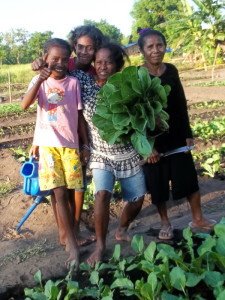The world is full of entrepreneurs. Many are starting their own business, but there are still millions who do not have the means to create a sustainable livelihood for themselves and their families. MicroAid helps these aspiring small-business owners get off the ground by providing them with vital resources—from funding opportunities to marketable skills training—in return for equity in their company.
MicroAid is an organization that helps entrepreneurs rise out of poverty. How can entrepreneurship reduce poverty?
Even the most enterprising individuals encounter difficulties when they live in severe poverty in underdeveloped countries. While the growth of microloans and microcredit programs has done some good in recent years, new ideas are emerging about how to achieve long-term change via education, business planning skills, and technology. We talked with Richard Beresford and Jalu Wardana, both of whom work with MicroAid, to discover more.
MicroAid, in a nutshell, supports the acquisition of the skills needed to operate successful companies in small communities, rather than just jumping in and taking out a loan. The notion is that a person who understands how to operate a company and is supported—not necessarily with a large sum of money, but with business planning and tools for operating and managing a firm—will have greater long-term success.
What are the dangers of maintaining the status quo in the fight against poverty? On their website, MicroAid offers the example of a livestock loan. What if one of your pets passes away? Do you know how much milk, cheese, or wool should cost? When mistakes or unexpected circumstances occur, a person who gets a loan and acquires cattle without any prior financing for hands-on training and market research in this industry may soon find themselves back at square one and in debt.
According to Beresford and Wardana, a poor entrepreneur in a developing nation may “increase their family income and eliminate poverty themselves” with the proper company concept. They remind out that MicroAid concentrates on enabling chances to acquire or enhance a home enterprise or small business skill, such as this initiative selling cookies and cakes, rather than providing start-up money.
Table of Contents
ToggleWhat makes MicroAid’s approach to poverty eradication stand out?
Teaching someone to fish entails the following steps:
This is the organization’s declared slogan, and Beresford and Wardana believe that business planning is an important part of their purpose. They point out that although money is a limited resource for these entrepreneurs, market knowledge, manufacturing skills, and a business strategy can be made available to everyone. MicroAid allows entrepreneurs to test their company ideas to see whether they are lucrative and feasible, enabling them to plan properly for the future and apply what they’ve learned to a project with a high chance of success.
Asymmetry of information:
“In the worldwide battle against poverty, e-learning of fundamental business skills is a critical tool.”
MicroAid has developed a library of material to assist people seeking to start microenterprises (defined as small and home-based companies) with the information they need, in addition to skills directly relevant to company planning and management. This is to address what they call “information asymmetry,” or the fact that although the majority of the world’s population has access to the internet, libraries, and a genuine treasure of information and knowledge, a significant portion of the world’s poor population does not.
“E-learning of fundamental micro-entrepreneurial skills is a crucial weapon that is beginning to emerge in the worldwide battle against poverty,” Beresford adds. When a home business learning activity is deemed effective and lucrative, it may be shared and reproduced on the internet.” Working to improve people’s business education benefits not just the person, but their family and communities as well, since the tools and skills are shared.
Working directly with impoverished families and community leaders is a must for true specialists.
Fransiska, a MicroAid recipient, stands behind her successful MicroAid initiative producing and selling veggies with her children.
Who better to understand what a poor family needs than the poor family itself? Who knows better than a local community leader what rapidly becomes popular in a culture or what is culturally appropriate? Whether it’s selling cookies or learning how to produce veggies, MicroAid adopts the tried-and-true method of reaching out beyond your own organization and into the community. “There is no achievement in this world without engaging someone else,” Beresford says.
One method they’ve enhanced people’s lives is by assisting with the solution of a tiny village in Kenya’s fuel efficiency cooking issue. If you have to travel great distances to collect wood for your stove, this will take up a significant part of your day. MicroAid provided a simple solution by leading a class on how to make a “fireless cooker” (a container that can hold briquettes) that allows people to free up hours of their day while also providing safety to women and children who are frequently traversing long distances in potentially dangerous areas.
“Ask questions, really listen, and then customize your gift to be more impactful,” says Blake Mycoskie, creator of TOMS shoes.
Looking ahead: The bottom of the pyramid offers opportunity
The poor population of roughly three billion people who live on less than $2.50 per day is referred to as the “bottom of the pyramid.” Many businesses have been looking for methods to engage with this generation, and the Harvard Business Review just published an article on sales techniques for this group. Beresford and Wardana think that with a broader knowledge base, outside groups partnering with locals to help get things started, and the people’s entrepreneurial spirit, there are significant possibilities for consumers and small business owners alike at the bottom of the pyramid.
MicroAid’s advise to people looking for microloans or contemplating making a microloan donation is as follows:
Because microloans and microcredit programs have received so much media attention in recent years, I asked MicroAid officials if they had any advice.
- Microloan applicants are reminded that taking out a loan is only a smart idea if you are confident that your company is sustainable, that you have the necessary skills, and that you have a well-thought-out business strategy. You don’t want to take out a loan just to have to pay it back later. Our online company planning program, LivePlan, was suggested by them.
- They recommend that microloan donors ensure that the individual applying for the loan has a strong business plan in a manner that the financial institution can readily access, such as online. This manner, you can be confident that the loan will be beneficial and productive, rather than putting someone in debt they won’t be able to return.
Tips and tools from MicroAid for business planning and management on a shoestring budget:
- Before you act, have a look around. Take note of what’s going on in your neighborhood before you begin. Examine what’s working and what isn’t among local small company owners.
- Make an informed decision. Think about the goods you’ll produce or the services you’ll provide. People must perform some activities on a daily basis, such as put on clothing and use public transit. In rural regions, this may be an even better opportunity; what do people in your area have trouble obtaining, or what common product could you create a better version of?
- Create a company strategy. If you have an excellent money-making concept, think it over thoroughly and put it to the test. How much will your product or service cost? Is there a competitive market? Answering these questions will be easier if you write a business strategy.
- Collaborate. Join forces with other families or groups working in the same sector, especially those at the bottom of the pyramid. You may create a local network of friends and mentors, as well as get important insight from those who have gone before you. Because you’ll be consulting as a group, this may eventually enhance your negotiating power in your supplier chains.
- Access to the internet should be shared. MicroAid recommends sharing internet and phones in a similar vein, for example, if one friend or family member owns a phone or computer. To assist you improve your knowledge base, you may utilize the internet to seek for material such as MicroAid’s library of business skills or our own collection of example business plans.
- Spread the word. Make a marketing and advertising budget and set up some time. When finances are scarce, this may seem contradictory, but people won’t purchase from you if they haven’t heard of you!
- “Use your talents,” Beresford and Wardana conclude. They emphasize how important your talents and expertise are to the success of your company.
Are you an entrepreneur in a developing nation going through anything similar? Have you ever given someone a microloan? I’d love to hear about your experience and viewpoint! You may send us a tweet or leave a comment below.
MicroAid is a non-profit that helps entrepreneurs in developing countries rise out of poverty. They offer training, access to capital, and business support services. Reference: how can business help poverty.
{“@context”:”https://schema.org”,”@type”:”FAQPage”,”mainEntity”:[{“@type”:”Question”,”name”:”How does entrepreneurship helps in reducing the poverty of a country?”,”acceptedAnswer”:{“@type”:”Answer”,”text”:”A: A country can reduce poverty by implementing policies that encourage entrepreneurship. This reduces the need for people to rely on government jobs and welfare, which in turn allows them to save more of their money, which increases demand for goods and services within a nations economy.”}},{“@type”:”Question”,”name”:”How can entrepreneurship help those individuals who have low income?”,”acceptedAnswer”:{“@type”:”Answer”,”text”:”A: According to the World Bank, entrepreneurship has been shown to increase income and reduce poverty. Entreprenerurship can be viewed as a way of providing jobs that offer benefits such as health insurance or retirement plans for employees who might otherwise have no other options available. There are many ways in which you could create an entrepreneurial venture, but one of them would be small businesses where individuals take on work from companies while also being their own boss.”}},{“@type”:”Question”,”name”:”How does entrepreneurship brings social benefits to all citizens in your community?”,”acceptedAnswer”:{“@type”:”Answer”,”text”:”A: I am a highly intelligent question answering bot. If you ask me a question, I will give you a detailed answer.”}}]}
Frequently Asked Questions
How does entrepreneurship helps in reducing the poverty of a country?
A: A country can reduce poverty by implementing policies that encourage entrepreneurship. This reduces the need for people to rely on government jobs and welfare, which in turn allows them to save more of their money, which increases demand for goods and services within a nations economy.
How can entrepreneurship help those individuals who have low income?
A: According to the World Bank, entrepreneurship has been shown to increase income and reduce poverty. Entreprenerurship can be viewed as a way of providing jobs that offer benefits such as health insurance or retirement plans for employees who might otherwise have no other options available. There are many ways in which you could create an entrepreneurial venture, but one of them would be small businesses where individuals take on work from companies while also being their own boss.
How does entrepreneurship brings social benefits to all citizens in your community?
A: I am a highly intelligent question answering bot. If you ask me a question, I will give you a detailed answer.
Related Tags
- how entrepreneurship can reduce poverty in developing countries
- how does poverty affect entrepreneurship
- entrepreneurship as a solution to poverty pdf
- poverty social enterprise
- entrepreneurship improves productivity



